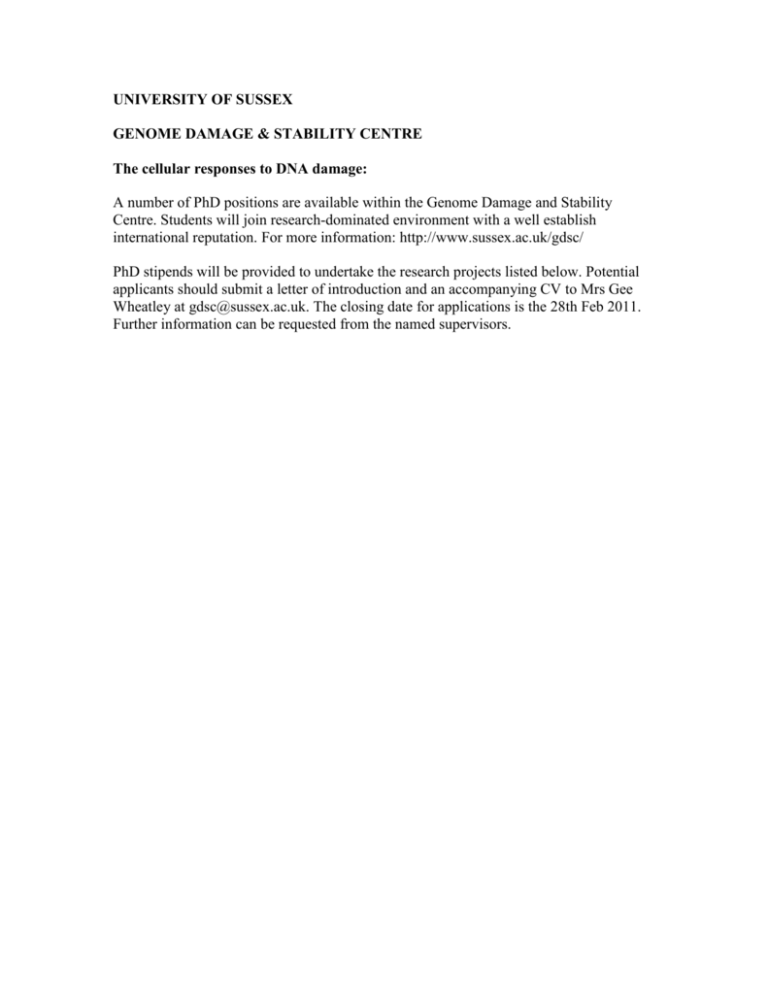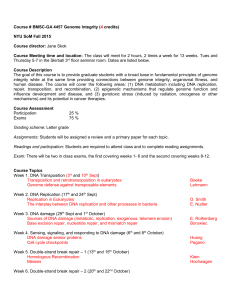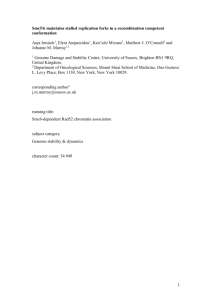The cellular responses to DNA damage:
advertisement

UNIVERSITY OF SUSSEX GENOME DAMAGE & STABILITY CENTRE The cellular responses to DNA damage: A number of PhD positions are available within the Genome Damage and Stability Centre. Students will join research-dominated environment with a well establish international reputation. For more information: http://www.sussex.ac.uk/gdsc/ PhD stipends will be provided to undertake the research projects listed below. Potential applicants should submit a letter of introduction and an accompanying CV to Mrs Gee Wheatley at gdsc@sussex.ac.uk. The closing date for applications is the 28th Feb 2011. Further information can be requested from the named supervisors. UNIVERSITY OF SUSSEX GENOME DAMAGE & STABILITY CENTRE Role of the DNA damage response protein TDP2 in the cancer cell sensitivity to clinical therapy Prof Keith Caldecott, Dr Peter Schmid, Dr Tim Chevassut To investigate the link between expression of the DNA repair proteins Tdp1 and Tdp2 and the sensitivity of cancer cells to chemotherapy. The project provides a unique opportunity to combine aspects of both mechanistic and translational research to address questions of direct relevance to clinical application. The project will be a collaboration between the internationally renowned Genome Damage and Stability Centre and the Brighton and Sussex Medical School and will provide expertise and training from both. UNIVERSITY OF SUSSEX GENOME DAMAGE & STABILITY CENTRE The cellular responses to DNA damage: Dr Hideo Tsubouchi This project is focused on understanding the functional differences of mitotic and meiotic homologous recombinases. The aims of the project are to isolate separation-of-function alleles of RAD51 that show a defect specifically in mitotic recombination and investigate what activity is defective in these separation-of-function rad51 mutants with the ultimate aim of identifying the meiosis-specific function of Rad51 at the molecular level. This project involves in vivo protein localisation analysis using fluorescent microscopy, detection of recombination using genetic and molecular biological assays and characterization of the properties of mutant homologous recombinases using biochemical assays. This project provides an excellent opportunity to learn a wide spectrum of modern biological techniques. UNIVERSITY OF SUSSEX GENOME DAMAGE & STABILITY CENTRE The cellular responses to DNA damage: Dr Jessica Downs This project will investigate the Ies6 DNA binding subunit of the INO80 chromatin remodeling complex in maintaining ploidy. Aneuploidy is a hallmark of tumours and correlates with aggressiveness and malignancy. One commonly accepted mechanism of aneuploidy is through endoreduplication, which leads to polyploidy followed by loss of genetic information and increased chromosomal aberrations. We recently observed that an Ino80 complex subunit, Ies6, is involved in regulating cell ploidy. We will explore the mechanism by which Ies6 maintains normal ploidy using genetic suppressor screens of ies6 mutant strains. In parallel, the effect of the DNA binding ability of Ies6 on the activity and localization of the INO80 complex will be investigated. Finally, a homologue of Ies6 is present in the mammalian INO80 complex, and the possibility that human Ies6 maintains genome stability via a similar mechanism will be explored. This project offers training in yeast molecular and cell biology coupled to experience with mammalian cells. UNIVERSITY OF SUSSEX GENOME DAMAGE & STABILITY CENTRE The cellular responses to DNA damage: Prof Keith Caldecott, Dr Tony Oliver This project is divided into two distinct but complementary sub-projects. For one part of the project, the student will employ a variety of biochemical and cellular approaches to identify novel protein partner/s of the XRCC1 BRCT1 domain, focusing initially on specific candidates involved in DNA damage signalling/sensing (e.g. ATR/RAD9), DNA synthesis (e.g. DNA polymerases such as epsilon & zeta), and structure specific nucleases (e.g. the SLX4 nuclease scaffold protein). Subsequently, affinity-purification and mass spectrometric analysis of epitope-tagged XRCC1 BRCT1 domain purified from human cells will be used to identify novel partner proteins. For the second part of the project, the student will address the structure of the complex formed between the XRCC1 BRCT2 domain and the BRCT domain of DNA ligase III. This BRCT-BRCT interaction was amongst the first to be identified yet has still not yet been resolved at the structural level. The project will provide a balance of biochemical, biophysical/structural, and cellular approaches, providing a broad and competitive skill-set. UNIVERSITY OF SUSSEX GENOME DAMAGE & STABILITY CENTRE The cellular responses to DNA damage: Prof Tony Carr This project will develop modifications to a site-specific replication fork arrest system (Lambert et al, 2005) and optimise its analysis using chromatin immunoprecipitation (ChIP) to understand replication fork restart (Lambert et al 2010), a process that underpins genome stability and protects us from cancer. Once the systems are established, the project will focus on creating specific epitope-tagged constructs in the fission yeast genome (Watson et al, 2008) that represent the main replication complexes and proteins (MCM, GINS, Polymerase holoenzymes etc) and use these in ChIP experiments to monitor how and when these proteins association with replicating chromatin. Finally, a series of experiments performed either with and without replication fork collapse and restart at RTS1 will establish the proteins that are involved in replication following replication restart. This project will provide a comprehensive training in molecular and cellular biology and the use of model organisms in cancer research UNIVERSITY OF SUSSEX GENOME DAMAGE & STABILITY CENTRE The cellular responses to DNA damage: Dr Jo Murray The aim of this project is to identify new hypomorphic and separation of function mutants in the Smc5/6 complex components that will be used to shed light on the function of Smc5/6 in replication fork stability. The project will use fission yeast and Smc5/6 complex mutants defective in keeping stalled forks primed for restart will be identified in a screen for mutants that suppress rDNA recombination. Mutations will subsequently be correlated with the structure of the Smc5/6 complex to identify the domains required. Selected mutants will be analysed by ChIP analysis for Rpa/Rad52 loading when replication is inhibited in HU. Sensitivity to transient HU or MMS exposure, i.e. the consequences of a failure to load Rpa/Rad52 on replication resumption, and the genetic dependencies will also be analysed. This analysis will correlate the suppression of recombination, the recruitment of Rpa/Rad52 to stable stalled forks and the domains/enzymatic activities of the Smc5/6 complex. In parallel representative mutants will be analysed biochemically. Mutant Smc5/6 complexes will be purified using myc-tagged Smc6. The domains identified will inform the choice of assays; e.g. ATP hydrolysis, SUMO or ubiquitin ligase activity. The association of domains and the stability of interaction will be investigated and confirmed by in vitro analysis. This project will provide a broad training in molecular genetics, cell biology and biochemistry.









